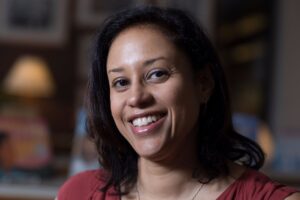
What children read can have a big influence on their future friends.
Krista Aronson, associate dean of the faculty and professor of psychology at Bates College, explores how reading a diverse range of stories can have an impact.
My work focuses on illuminating how people come to understand complex social constructs like race and ethnicity, including how children process and understand race as well as appropriate, effective and productive ways to discuss this topic with them; specifically, the effective use of picture books to enhance intercultural relationships and self-understanding during childhood.
This work draws heavily on the Diverse Book Collection. Founded by myself in collaboration with Anne Sibley O’Brien, children’s book creator, and Brenna Callahan (’15), this circulating collection is comprised of fiction and narrative non-fiction picture books (grades K-3) depicting characters of color published in the United States between 2002-and the present. This is the only circulating collection of its kind.
Using the collection my collaborators and students and I contribute to the national dialogue about diverse children’s books, capturing and communicating their dominant messages and exploring their impact on inclusion and bias, including how teachers and parents can utilize them in everyday life. The Diverse BookFinder is a free, online searchable database of the collection. Supported by a National Leadership Grant from the Institute for Museum and Library Services, this resource is designed to facilitate the identification of multicultural titles, so that all our children can find themselves reflected and celebrated in libraries, schools and homes across the nation.
Diverse BookFinder
Picture books that depict children making positive connections across racial difference can directly impact the attitudes of children who read them. In research investigating how kids respond to cross-racial depictions in picture books, my colleagues and I found that when children were read books depicting characters from different races having fun together, they reported greater comfort and interest in playing across racial difference. More importantly, these gains remained somewhat stable three months after the study was complete.
The outcomes of this research led us to ask, what other themes or messages are prominent in children’s picture books featuring Black and Indigenous people and People of Color or BIPOC? Collecting and coding recent picture books, we discovered nine dominant categories. Our research grew into the Diverse BookFinder, an ever-expanding, publicly accessible, online database of more than 3000 picture books featuring BIPOC characters published since 2002.
Our database offers information about not just who is represented in diverse picture books, but how — that is, what categories are most common for which racial groups? These categories make it possible to ask: What messages are picture books sending about BIPOC? And what impact do these messages have on children? For instance, if the majority of picture books featuring African Americans are about oppression — like slavery and racial segregation — how does this affect Black children, white children, and other children of color? Furthermore, our free Collection Analysis Tool is designed specifically to help public librarians audit the racial representation of their picture book collections and enrich those collections according to the needs of their local communities.
Our research and resulting database allows anyone — scholars, parents, educators, librarians, book creators and publishers — to better understand the impact of and advocate for a broader range of stories that truly represent the full and complex humanity of the world around us.


Comments
3 responses to “Krista Aronson, Bates College – Diverse BookFinder”